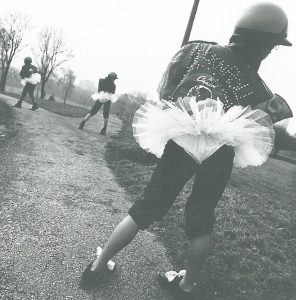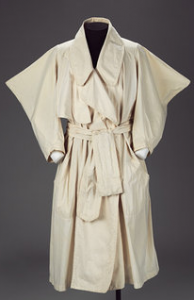Androgynous Fashion
This image was found in “Women and Fashion: A New Look” by Caroline Evans and Minna Thornton. I picked up this book and found this picture (1) and the text on the page lead me to start to explore this topic of ‘androgyny’ which refers to the combination of both feminine and masculine characteristics.
Whilst researching into androgyny I came across many figures such as Grace Jones, Marlene Dietrich and David Bowie. With further research I came across this review on WordPress about an exhibition in the V&A to do with androgyny and it included Vivienne Westwood. I explored the V&A records using Vivienne Westwood and came across an article called “Vivienne Westwood: Punk, New Romantic and beyond” which included many garments she has made that the V&A have in their possession. I looked into some of the items and read the information but found the “witches” coat (2) to link to androgyny because it was the first item that was not linked to either male or female clothing but visually you can see how it is unisex as it takes the traditional practical trench coat and infuses the creativity amongst women’s clothing through the exaggerated sleeve shape.
Before looking into androgyny I thought it was only referred to as unisex fashion that was a modern fashion trend due to the rise in feminism and acceptance of the LGBT community. One article by oxford student stated that androgyny can be dated back to the 17th century with western European styles consisting of men wearing wigs and petticoat breeches that looked like skirts. There were key people who were involved in making androgyny popular such as Chevalier d’Éon in the 18th century who was a soldier was known to dress either masculine or feminine and Marlene Dietrich in the 1930s who helped popularise women’s suits.
I browsed the V&A archives of their collections and typed in androgyny and found an outfit that consisted of a dress, tank top and feather boa (3). It was made by Biba in 1971 and worn to the Gay Liberation Front ball in Kensington. Biba is said to be a brand that was worn by feminists and members of the LGBT community. There was also a photograph taken in the 80s of Jeny Howorth who has short hair and is dressed in a double breasted suit which is fitted with a long coat with shoulder pads. At a quick glance you wouldn’t see the feminine features as the silhouette creates a male figure the background image of a zoom in of Jeny’s face highlights the feminine features.
Bibliography
http://www.vogue.co.uk/gallery/fashion-androgynous-icons-annie-lennox-prince-david-bowie
https://collections.vam.ac.uk/item/O136252/witches-raincoat-and-belt-vivienne-westwood/
https://www.vam.ac.uk/articles/vivienne-westwood-punk-new-romantic-and-beyond
http://collections.vam.ac.uk/item/O140982/dress-biba/
http://collections.vam.ac.uk/item/O1061098/photograph/



